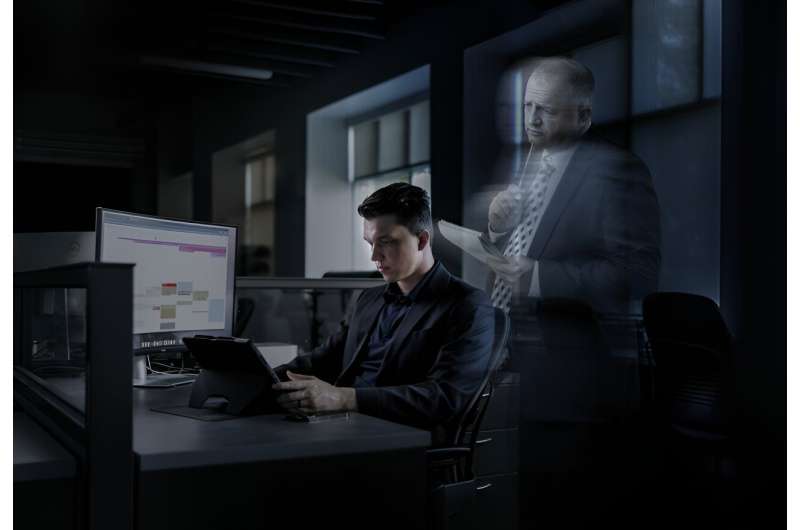This article has been reviewed according to Science X's editorial process and policies. Editors have highlighted the following attributes while ensuring the content's credibility:
fact-checked
peer-reviewed publication
trusted source
proofread
Organizational ghosts: Admired former leaders who continue to have outsized influence

Jeff Bednar is a ghost hunter. And while the BYU business professor doesn't have night vision cameras or ultra-sensitive recording equipment, he's found a bunch of them—including several here at BYU.
The ghosts Bednar and University of Illinois colleague Jacob Brown are hunting sound similar to the ghosts you've heard of—they linger long after they've left this life and hover over their previous haunts—but they're not necessarily the kind of ghosts that show up around Halloween.
They're called organizational ghosts: admired former leaders that become embodied prototypes of the organization's values and identity who continue to have outsized influence long after they've departed. Think Walt Disney, Coco Chanel or Steve Jobs. And it turns out these organizational ghosts tend to visit their old stomping grounds pretty regularly.
"Organizational ghosts can manifest themselves in a number of different ways," said Bednar, an associate professor in the Marriott School of Business. "It could be in the form of someone asking themself if a former leader would be proud of what they're doing, or they might imagine how a former leader would approach a certain task before attempting it themselves."
These individuals transcend their physical presence, becoming immortalized within the organization and living on through associative learning, perpetuated practices, and collective memory. The research, published recently in the Academy of Management Journal, found that organizational ghosts can serve to safeguard organizations from risky decisions, legitimize the actions of current leaders, or devalue new leaders or other organizations.
Bednar himself regularly experienced "ghostly encounters" with an organizational ghost when he interned at Walmart Headquarters in 2005. He noticed that the buildings he worked in had pictures and quotes of Walmart founder Sam Walton, who passed away in 1992, all over the walls, and employees constantly referenced Sam and told stories about him. Bednar was intrigued by the impact that Walton still had on the company more than 10 years after his death.
"People in meetings were always talking about how they should try to do things the way Sam would have," Bednar said. "It fascinated me the impact and influence a leader could have on an organization even after they're gone."
Bednar and Brown's research discovered is that it isn't just the founder of an organization that can become an organizational ghost. Any leader who makes a profound enough impact on showcasing and embodying the values of an organization can leave a lasting legacy that transcends their tenure.
Here at BYU, past prophets such as President Spencer W. Kimball have become profoundly influential organizational ghosts. In 1975, President Kimball delivered a seminal address about the future of BYU referred to as the "Second Century Address." That address and the words of President Kimball continue to have significant influence (and guidance) over the university.
Hall of Fame football coach LaVell Edwards, who led BYU to a national championship in 1984 and is oft-cited by current coach Kalani Sitake as his mentor, is another example of an organizational ghost at BYU.
Once the memory of these individuals is embedded in the minds and hearts of those who are a part of an organization, they often become preserved in physical artifacts and practices too, such as a newly planted tree, a parking space, an office, or a room named after the organizational ghost. Or, in the case of LaVell Edwards, a football stadium. As a result, they can be "activated" in the minds of members when members imagine how they might approach a certain decision or recall the actions of a ghost and use that to influence their own actions.
But, "ghost hunting" isn't just for researchers like Bednar and Brown; everyone should be aware of the ghosts in their lives and the ways they continue to influence them.
"Which ghosts are most influential in your life? And how do they impact the way you think, feel, and behave?" Bednar said. "For me, one of the most important leadership lessons from this study was the importance of being aware of the historical dynamics that are always operating in the background in organizations. New leaders need to be especially conscious of those that have gone before them as they are making decisions that affect others in organizations."
More information: Jeffrey S. Bednar et al, Organizational Ghosts: How "Ghostly Encounters" Enable Former Leaders to Influence Current Organizational Members, Academy of Management Journal (2023). DOI: 10.5465/amj.2022.0622
Journal information: Academy of Management Journal
Provided by Brigham Young University



















